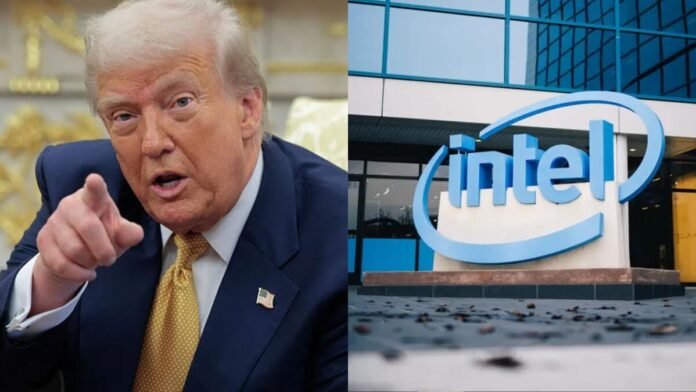In a dramatic policy reversal, President Trump’s administration has quietly pivoted from demanding Intel’s CEO resign to endowing the U.S. government with a near-10 percent ownership stake in the chipmaker. The $8.9 billion investment, structured as an equity stake, has generated a maelstrom of commentary—from industry relief to ideological alarm.
U.S. Government – Intel $8.9 billion Deal
Under the deal, the U.S. government will acquire 433.3 million shares of Intel common stock at $20.47 per share, amounting to a 9.9% stake in the company. Rather than new funding, the investment repurposes $5.7 billion in unpaid grants under the CHIPS and Science Act and $3.2 billion from the Secure Enclave defense program.
This agreement converts previously allocated government backing into taxpayer equity, effectively making Intel one of the first major private tech firms partially owned by the federal government. Intel confirmed that this ownership will remain passive, with no board seats or governance rights, although the government must generally vote in line with the board—with certain narrow exceptions. Additionally, the government receives a five‑year warrant at $20 per share, enabling acquisition of up to 5% more Intel stock, exercisable only if Intel’s control over its foundry business falls below 51%.
From “Resign Immediately” to Strategic Partner
Just weeks ago, President Trump publicly called on Intel CEO Lip‑Bu Tan to step down, citing alleged conflicts of interest tied to business dealings in China. But after a White House meeting on August 11, the tone changed. Trump said Tan “walked in wanting to keep his job and ended up giving us $10 billion” for the country. The agreement thus marks a remarkable turnaround—from confrontation to alignment.
A Break from Free-Market Orthodoxy
Observers across the political spectrum are questioning the implications of this move. Critics warn that turning grants into equity exemplifies government overreach, risking politicized decision‑making in corporate governance. Scott Lincicome of the Cato Institute called it a troubling shift, warning of market distortion and potential erosion of investor confidence. Senator Thom Tillis challenged how this aligns with conservative free‑market values, while Rand Paul labeled it akin to creeping socialism
This shift is reminiscent of crisis-era interventions—like the Obama administration’s bailout of General Motors—but is far less common in America’s tech sector. Lincicome warned of government nudging companies like Intel toward political goals at the cost of corporate independence.
Analysts Sound a Cautionary Note
Even proponents caution skepticism. Reuters reports that analysts believe government backing alone may not resolve Intel’s structural challenges—particularly its struggling foundry business, yield issues, and lack of external clients. Given severe competition from TSMC and Nvidia, analysts question whether financial support can translate to regained market leadership.
Bloomberg Intelligence stressed that passive ownership still wields influence, potentially constraining Intel’s strategic flexibility. Market reactions were modest: Intel stock rose about 5.53% during regular trading.
Strategic Context and Broader Agenda
This deal aligns with Trump’s broader strategy of using equity, licensing, and export licensing to coax U.S. tech firms into aligning with his national‑security goals. Recent deals include arrangements with Nvidia and AMD, helping them export chips to China in exchange for revenue‑sharing commitments. Intel’s stake signals intention to expand market interventions, though the administration reportedly has ruled out similar stakes in other firms like TSMC or Micron.
Meanwhile, this move delivers a lifeline for Intel’s mega‑fab projects in Arizona and Ohio, which need continued capital to push towards high‑volume production.
What Comes Next?
For now, the U.S. has become Intel’s largest single shareholder—albeit with limited power—and the deal provides much‑needed funding without additional congressional appropriation. But risks linger:
- Corporate governance: Will strategic autonomy suffer?
- Legal challenges: Observers question if reassigning grants into equity is allowable under CHIPS Act rules.
- Industry precedent: This could herald similar interventions across tech if unchecked.
- Performance over politics: If Intel cannot translate this into commercial success, many investors may view the deal as symbolic rather than substantive.
Conclusion
President Trump’s abrupt pivot—from calling for Lip-Bu Tan’s resignation to embracing him as a partner—caps a stunning political and economic reversal. The U.S. government’s equity stake in Intel is historic, blending industrial policy with fiscal strategy. But while it buys time and stability for Intel, the deal may reshape the tech-market divide in ways that will outlast any single administration.
The key question now: Will this investment be the spark Intel needs to reclaim leadership? Or will government ownership introduce new constraints at the worst possible moment?
Read Also: Why Investors Are Paying Attention to Strategy’s $2.47B Bitcoin‑Fueled IPO
Disclaimer: This article is for informational purposes only and does not constitute investment advice.




